breakers
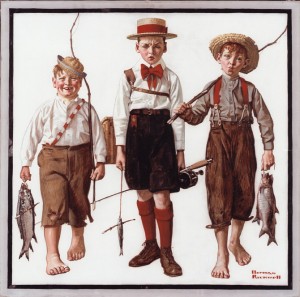 Been fishing lately? If you have, I bet you’ve noticed that there are a lot of suspended fish this time of year. There’s nothing more frustrating to Chesapeake Bay light tackle fishermen than to see nice marks on the fish finder, then not get bites. How do you catch those finicky suspended rockfish? Frankly, it’s tough, but there are some things you can do to increase your chances. To start, consider what’s going on below the surface.
Been fishing lately? If you have, I bet you’ve noticed that there are a lot of suspended fish this time of year. There’s nothing more frustrating to Chesapeake Bay light tackle fishermen than to see nice marks on the fish finder, then not get bites. How do you catch those finicky suspended rockfish? Frankly, it’s tough, but there are some things you can do to increase your chances. To start, consider what’s going on below the surface.
1. Scope Out The Situation – Stripers adjust their feeding habits depending on conditions. Since the Chesapeake Bay is an estuary, conditions can change frequently. Sometimes changes are short-term like those brought on by tides and currents. Sometimes, they last longer like with seasonal water-temperature adjustments. There are even cases where conditions can change for years at a time.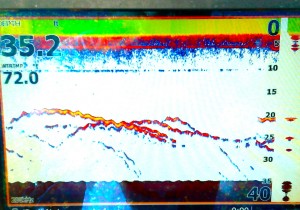
In the near-decade that I’ve been fishing the Chesapeake, I’ve noticed a change, particularly in the warmer months, to more fish feeding in temperate mid-level zones in open water. This can happen when the water conditions on the surface are not as comfortable as they are farther down. In the spring when we get a lot of rain, storm water runs off polluted roads, parking lots, fertilized lawns, and farmer’s fields resulting in a surface layer of unsalted, polluted water. Stripers will come up to feed in this layer when conditions are good and when they’re very hungry, but they’ll drop back down into the comfort zone when they aren’t extremely active. They usually won’t swim down deeper than forty feet or so because the water down deep may not hold enough oxygen, or the temperature or salinity can be uncomfortable for them. Read More!
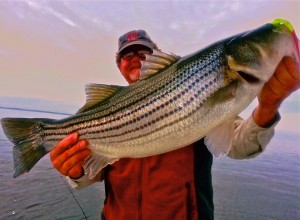 One of the more frequently asked questions I get whether by email or in person is, “How can I consistently catch bigger fish?” I’ve written about moving your game up to the next level before, but since we now have some migratory stripers in the Maryland part of the Chesapeake Bay, it’s worthwhile to address it again. The learning curve gets a little shorter in the fall and it’s a great chance to sharpen your skills. I’ll start by saying there are no hard and fast rules for catching stripers. Over my years of casting for them I feel like I’ve honed my techniques so that, on any given day, I have an edge for catching a trophy. That said, I’m still frequently surprised when a huge striper is caught by some completely different method than I’ve seen before. One thing is for sure, things change. There’s no substitute for experience but anglers who aren’t willing to stay on top of the latest innovations and newest techniques are certain to be left behind. Read More!
One of the more frequently asked questions I get whether by email or in person is, “How can I consistently catch bigger fish?” I’ve written about moving your game up to the next level before, but since we now have some migratory stripers in the Maryland part of the Chesapeake Bay, it’s worthwhile to address it again. The learning curve gets a little shorter in the fall and it’s a great chance to sharpen your skills. I’ll start by saying there are no hard and fast rules for catching stripers. Over my years of casting for them I feel like I’ve honed my techniques so that, on any given day, I have an edge for catching a trophy. That said, I’m still frequently surprised when a huge striper is caught by some completely different method than I’ve seen before. One thing is for sure, things change. There’s no substitute for experience but anglers who aren’t willing to stay on top of the latest innovations and newest techniques are certain to be left behind. Read More!
![1229121347-1[1]](http://www.chesapeakelighttackle.com/wp-content/uploads/2012/12/1229121347-11-300x220.jpg) By all accounts, 2012 was an unusual year for fishing. For me, it was absolutely strange at times. I jigged up my biggest striper of the year on the first day of the year, a 49-incher that might have pushed 50-pounds. It was the only fish I caught. A few days later I got another 47-incher and another one about that size on the next day. Each time it was only one fish per day. Is one fish worth five hours or more of casting? When they’re that size, I think so! Those were some of my biggest fish of 2012, but I’ve been lucky enough to jig up a few more mid-40s class fish since then including this pretty 45-incher I caught in the snow this week. Warm water discharge (WWD) fishing was good last spring, but we really had to pick our days. Our most successful times were early-morning windy weekdays when it was raining or snowing. The WWD big fish bite is always very specific. I explain how to get the trophies in my book, Chesapeake Light Tackle, An Introduction to Light Tackle Fishing on the Chesapeake Bay. Read More!
By all accounts, 2012 was an unusual year for fishing. For me, it was absolutely strange at times. I jigged up my biggest striper of the year on the first day of the year, a 49-incher that might have pushed 50-pounds. It was the only fish I caught. A few days later I got another 47-incher and another one about that size on the next day. Each time it was only one fish per day. Is one fish worth five hours or more of casting? When they’re that size, I think so! Those were some of my biggest fish of 2012, but I’ve been lucky enough to jig up a few more mid-40s class fish since then including this pretty 45-incher I caught in the snow this week. Warm water discharge (WWD) fishing was good last spring, but we really had to pick our days. Our most successful times were early-morning windy weekdays when it was raining or snowing. The WWD big fish bite is always very specific. I explain how to get the trophies in my book, Chesapeake Light Tackle, An Introduction to Light Tackle Fishing on the Chesapeake Bay. Read More!
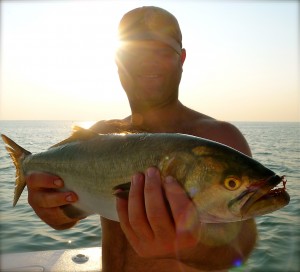 Not long ago we took breaking bluefish and rockfish for granted in the Chesapeake Bay. Unfortunately, times have changed. Since there are a lot fewer fish now, we have to look a lot harder and longer for summer breakers. Granted, it’s easier on some days than it is on others. In my book, Chesapeake Light Tackle, An Introduction to Light Tackle Fishing on the Chesapeake Bay, I dedicate several pages to methods for locating breaking fish. The best strategy for finding blitzing fish under working birds is to head straight for the closest oyster bar. In my reports, I often mention that I find fish over live, hard bottoms. By that, I mean places where there are active shellfish populations.
Not long ago we took breaking bluefish and rockfish for granted in the Chesapeake Bay. Unfortunately, times have changed. Since there are a lot fewer fish now, we have to look a lot harder and longer for summer breakers. Granted, it’s easier on some days than it is on others. In my book, Chesapeake Light Tackle, An Introduction to Light Tackle Fishing on the Chesapeake Bay, I dedicate several pages to methods for locating breaking fish. The best strategy for finding blitzing fish under working birds is to head straight for the closest oyster bar. In my reports, I often mention that I find fish over live, hard bottoms. By that, I mean places where there are active shellfish populations.
I typically plan all my fishing trips so that I keep my boat over as many oyster bars as possible. That includes when I’m just running from one place to another. For fish to feed on the surface in the Chesapeake Bay they need three primary ingredients. In the book, I abbreviate the formula like this: C + B/HB = BF. That’s current plus bait over hard bottoms equals breaking fish. Read More!
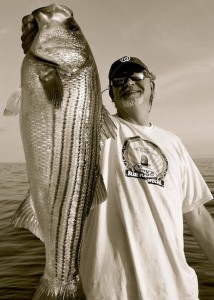 “There are no more deserts. There are no more islands. Yet there is a need for them. In order to understand the world, one has to turn away from it on occasion; in order to serve men better, one has to hold them at a distance for a time. But where can one find the solitude necessary to vigor, the deep breath in which the mind collects itself and courage gauges its strength? There remain big cities.” -ALBERT CAMUS from THE MINOTAUR.
“There are no more deserts. There are no more islands. Yet there is a need for them. In order to understand the world, one has to turn away from it on occasion; in order to serve men better, one has to hold them at a distance for a time. But where can one find the solitude necessary to vigor, the deep breath in which the mind collects itself and courage gauges its strength? There remain big cities.” -ALBERT CAMUS from THE MINOTAUR.
I must apologize for the lack of fishing reports lately. I’ve required some time to concentrate on other interests, dance for a while to the songs in my head, and step back to reassess some priorities after over-extending a little. I’m currently writing from a boat off the Florida Keys. I’ve been here for the past ten days or so. It’s been relaxing, rejuvenating actually, and I’ve enjoyed some successful fishing. My time for tuning out is about over, so next week I’ll be back working in the big city, and perhaps more importantly, back in the swing of the Chesapeake fishing scene. On August 20th I’ll speak to the Broadneck/Magothy MSSA chapter about Strike Triggers and Catch & Release techniques. The following night, August 21st, I’ll travel to the Essex/Middle River chapter to present a similar talk. On August 25th and 26th I’ll have a book-signing table and also give a couple of talks at the 6th Annual Maryland Buck Wild Outdoors Expo. Look for me all day Saturday and Sunday. Read More!
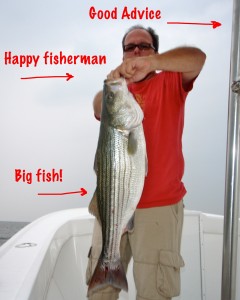 No man, after catching a big fish, goes home through an alley. – Ancient Chinese Proverb
No man, after catching a big fish, goes home through an alley. – Ancient Chinese Proverb
Maybe you’ve heard someone recite another old saying about “the three stages of a fisherman’s life.” It goes something like this: The first stage is when the angler’s main objective is to catch as many fish as possible, the second stage is when the angler only searches for the larger fish, and the third and final stage is when size doesn’t matter and the capture is unimportant, but satisfaction comes from the way the angler tricks the fish. I usually nod my head in agreement when I hear that, but c’mon now, I don’t know one single fisherman who, when given a choice, doesn’t cast toward the biggest fish in the pond. We can wax poetic about the joys of baptizing ourselves in the boundless beauty of nature, and we can sing the praises of that peaceful solitude we find out on the open water, but screw it – the bottom line is, no matter how we are fishing, we want to catch a whopper! In this third and final segment of the Gimme a Breaker series, we’re looking at ways to get the lunkers out of surface blitzing Chesapeake rockfish. Read More!


